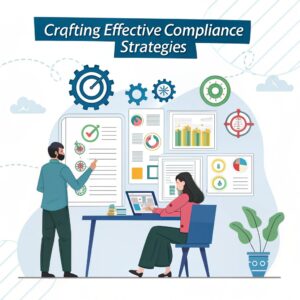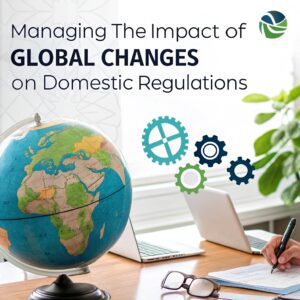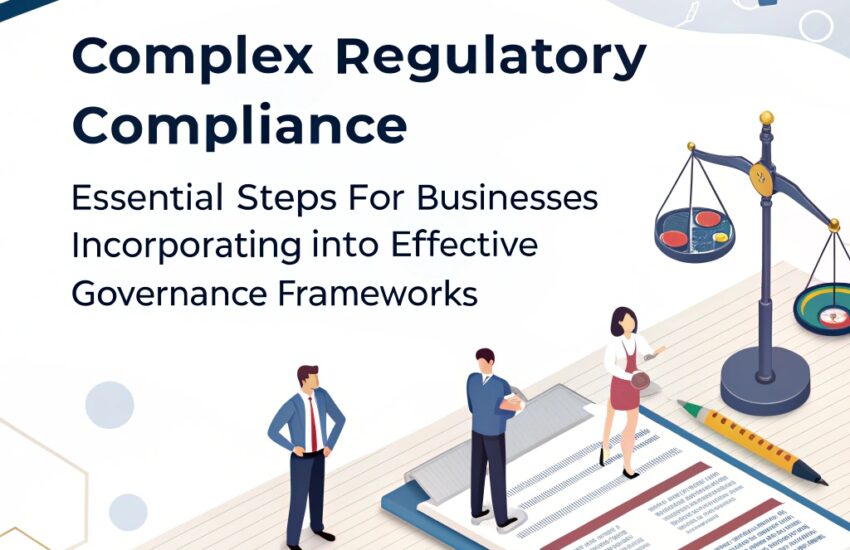As a business owner, staying on top of regulatory compliance can be overwhelming.
You’re probably aware that non-compliance can result in significant financial losses and even damage to your reputation. But complex regulations aren’t easy – it requires specialized expertise.
Our expert guidance will help you implement effective governance frameworks, ensuring your organization remains compliant with evolving regulations while minimizing disruption to operations.
In this comprehensive guide, we’ll break down the essential steps for businesses looking to streamline compliance and integrate regulatory requirements into their existing systems.
Adapting to Industry-Specific Regulations
Complex regulatory compliance can be a daunting task for businesses visa, but by incorporating industry-specific regulations into effective governance frameworks, it is possible to stay ahead of the curve.
To begin with, it’s essential to conduct thorough research on the specific laws and guidelines that govern your sector. This means delving deep into existing policies and procedures to identify areas where you may be vulnerable. Reviewing key legislation such as GDPR or HIPAA can help inform decisions about data protection and confidentiality.
Once a comprehensive understanding of regulatory requirements is established, it’s crucial to develop robust compliance protocols that cover all aspects of your operations. This includes implementing technology solutions like audit trails and encryption to safeguard sensitive information.
Effective communication with stakeholders – including employees, customers, and partners – is also vital in maintaining transparency around regulatory adherence. Regular updates on policy changes can help build trust and mitigate the risk of non-compliance.
By prioritizing industry-specific regulations from an early stage, businesses can avoid costly fines and reputational damage that often come with ignoring or neglecting compliance. Adapting to changing regulations requires a culture of continuous learning, allowing companies to stay competitive in their respective markets while protecting their interests.
Crafting Effective Compliance Strategies

Effective governance frameworks are the cornerstone of any organization’s ability to navigate complex regulatory environments. A well-structured framework is essential in ensuring adherence to laws and regulations, as it sets out clear roles and responsibilities, internal control systems, and stakeholder engagement strategies.
To ensure accountability throughout the organization, designate specific personnel responsible for managing compliance tasks. This includes creating clear job descriptions that outline expected duties, deliverables, and performance metrics. For instance, a Chief Compliance Officer should be responsible for overseeing policy development and enforcement; while a Data Protection Officer is accountable for ensuring data privacy and security measures are in place.
A robust internal control system can aid in preventing non-compliance issues from arising in the first place. This involves implementing IT security measures such as multi-factor authentication to access company databases, setting up regular financial transaction reviews, and maintaining accurate records of all transactions. By establishing a comprehensive backup process that includes daily data backups at 10 PM, organizations can mitigate potential data loss risks.
Moreover, engaging with stakeholders is crucial for staying informed about changes to laws and regulations that may impact your organization’s operations. Regular communication with regulatory bodies, industry associations, and internal teams helps ensure knowledge of emerging trends and updates in the compliance landscape. For example, companies like Google and Facebook have successfully navigated complex regulatory challenges through proactive stakeholder engagement.
When implemented effectively, an effective governance framework can provide a clear roadmap for the ever-changing landscape of regulations. This means being able to quickly respond to new laws or policies that impact business operations; in effect allowing your company to stay ahead of the competition while protecting its brand and reputation by avoiding compliance breaches that can result from failure on such issues.
By structuring these elements, organizations can create a clear understanding of their regulatory environment and ensure adherence to all necessary regulations.
Building Risk Management Frameworks for Governance
A well-implemented risk management framework is essential for businesses to navigate complex regulatory compliance.
Building a Risk Management Framework: Practical Steps
When complex regulatory landscapes, identifying potential risks and threats can be overwhelming. Here’s how to build an effective risk management framework:
Define Clear Objectives and Policies
Consider the recent data breach faced by Equifax in 2017. The company suffered significant losses due to inadequate cybersecurity measures, which highlighted the importance of clear policies for businesses.
To mitigate this risk, a financial institution must establish clear guidelines on incident response, employee training, and technology upgrades. This includes defining what constitutes an acceptable level of risk tolerance and setting specific performance metrics for compliance teams. By doing so, they can ensure that their regulatory requirements are met while minimizing potential losses.
Conduct Thorough Risk Assessments
Effective risk management starts with identifying areas of vulnerability. A real-life example is the WannaCry ransomware attack in 2017, which exposed vulnerabilities in unpatched software. To avoid similar incidents, businesses should conduct thorough risk assessments to pinpoint these weaknesses and prioritize remediation efforts.
Identify Roles and Responsibilities
A well-defined framework requires clear roles and responsibilities among stakeholders. For instance, a company’s board of directors must establish a compliance committee to oversee regulatory requirements, while employees need training on data protection procedures. By establishing defined roles, organizations can ensure accountability and effective communication throughout the risk management process.
Implement a Robust Monitoring System
Regularly scheduled audits are crucial for identifying changes in regulatory requirements before they impact business operations. A company’s IT department should establish an alert system to notify teams of potential compliance issues, ensuring prompt action is taken to mitigate risks.
By following these steps, businesses can build effective risk management frameworks that navigate complex regulatory landscapes and minimize the risk of costly mistakes.
Utilizing Technology in Regulatory Oversight

The rapid evolution of technology has transformed regulatory compliance, but one critical aspect remains unchanged: choosing the right tools to support effective governance frameworks. In today’s fast-paced business environment, a well-designed compliance system is crucial to complex regulatory landscapes and minimizing risks.
When considering different types of software solutions, businesses must carefully evaluate their data needs and determine which technology solution can help manage and track compliance requirements. This often means analyzing datasets such as customer complaints on social media (where AI-powered tools like Brand24 can be employed to monitor sentiment analysis), financial transactions for suspicious activity (utilizing machine learning algorithms in systems like IBM’s Risk Analytics), or regulatory reporting (leveraging data mapping techniques to identify gaps). These disparate pieces of information must then be integrated into a unified compliance framework.
The goal is always the same: streamline compliance processes while minimizing costs, ensuring faster incident response times and improved supply chain visibility. Technology can act as a strategic advisor, helping businesses pinpoint vulnerabilities in regulatory requirements and ensure ongoing monitoring to maintain an effective governance framework much like fitting puzzle pieces together seamlessly.
For instance, ACL’s Risk Manager or IBM’s InfoSphere Data Management solutions enable organizations to create compliance dashboards that provide real-time insights into risk exposure. By analyzing customer complaints on social media using natural language processing tools like Lexia or Hootsuite Insights, businesses can identify potential regulatory hotspots and proactively respond to emerging risks.
Technology is not just about solving a specific problem; it’s about transforming business operations from the ground up. When integrated correctly, these solutions help companies achieve compliance efficiency while reducing administrative burdens on staff ultimately leading to increased productivity and bottom-line growth.
Incorporating technology into regulatory oversight is no longer an option but a necessity for forward-thinking businesses seeking sustainable competitive advantages in todays fast-paced landscape.
Human Capital and Training Programs for Compliance Experts
A governance framework that effectively manages risk and ensures compliance requires more than just regulatory knowledge – it needs human capital, specifically trained employees who can navigate complex regulations. Inadequate training programs can be a major roadblock to compliance, leading to costly fines and reputational damage.
Developing comprehensive training programs is not a one-size-fits-all approach; instead, businesses must take the time to understand their unique risk profile and needs. By identifying areas where employees require upskilling or reskilling, organizations can create targeted programs that address these gaps. For example, a study by the American Bar Association found that companies with robust compliance training programs were 40% less likely to experience regulatory non-compliance incidents.
To make training effective, consider incorporating engaging scenarios and case studies that illustrate real-world examples of compliance successes or failures. Role-playing exercises can help employees develop practical skills for detecting and addressing potential issues. For instance, a chemical company in the pharmaceutical industry uses immersive simulations to educate employees on proper handling procedures for hazardous materials.
Continuous feedback is essential for refining training programs over time. Regular check-ins with management should involve structured bi-annual reviews that assess employee understanding of regulatory requirements and identify areas where improvement is needed. To measure progress, organizations can track key performance indicators (KPIs) such as compliance incident rates or audit findings. For example, a company in the financial services sector uses data analytics to monitor training effectiveness and adjust its programs accordingly.
Fostering an environment where transparency and accountability thrive is crucial for driving positive change within your organization. This requires more than just policy enforcement; it demands leadership commitment to compliance as part of their core values. To promote this mindset, consider regular meetings with employees that discuss compliance best practices and encourage open communication channels.
By focusing on these strategies, businesses can create a culture of regulatory compliance from the ground up – an environment where employees feel empowered to act in accordance with regulations without fear or favoritism. This proactive approach not only mitigates potential issues but also sets your organization apart as a leader in responsible business practices.
Identifying Gaps in Current Regulations and Proposals to Close Them
A critical first step for businesses looking to navigate complex regulatory compliance is to conduct an exhaustive review of existing laws and regulations. This thorough analysis ensures that your business operates within the boundaries set by governing authorities, reducing the risk of non-compliance.
To identify gaps in current regulations, map out all aspects of your business operations and compliance requirements. Consider reviewing industry-specific guidelines, company policies, and relevant government publications to get a comprehensive understanding of regulatory obligations. This step lays the foundation for effective gap closure and helps you determine which specific areas require attention.
Conducting stakeholder interviews is an invaluable tool in identifying potential compliance issues. By gathering insights from employees, customers, suppliers, and other parties involved in your business operations, you can pinpoint areas where changes are needed to ensure regulatory compliance. For instance, a stakeholder interview with a manufacturing employee might reveal concerns about product safety protocols or supply chain logistics. Similarly, discussing customer complaints with service department staff could highlight inconsistencies in communication channels or inadequate issue resolution processes.
Common pitfalls businesses encounter when trying to close gaps in regulatory compliance include:
- Underestimating the scope of regulatory requirements
- Failing to communicate changes effectively across departments and levels within an organization
- Ignoring emerging trends or new regulations that may impact business operations
To avoid these common mistakes, leverage your stakeholders as a sounding board for ideas. Use this opportunity to gather diverse perspectives on compliance issues, which can lead to identifying areas where changes are needed.
Another approach involves using technology to streamline regulatory processes and monitor potential risks. For example, leveraging social media analytics or data analytics tools can help identify compliance hotspots in real-time, allowing you to take proactive measures before any potential issues arise.
Moreover, a study by the Compliance Institute found that 75% of companies with effective governance structures are better equipped to address gaps in regulatory compliance.
Ultimately, businesses that proactively engage stakeholders and leverage technology to stay ahead of regulatory changes can reap significant benefits. By closing these gaps effectively, you can reduce the risk of non-compliance, improve operational efficiency, and enhance your organization’s overall reputation.
Role of Stakeholder Engagement in Compliance Initiatives
Stakeholder engagement is crucial for businesses’ complex regulatory compliance.
In today’s fast-paced business environment, stakeholder needs can clash with regulatory requirements. By fostering a dialogue that is regular, consistent, and based on mutual respect, organizations can mitigate potential risks and ensure smoother transitions to effective governance frameworks.
A notable example of this in action is the implementation of customer feedback forms by companies like Patagonia. The outdoor apparel brand has been successful in engaging its stakeholders through transparent communication channels. By doing so, they were able to improve employee satisfaction and reduce conflicts with regulatory requirements.
The benefits of stakeholder engagement are numerous. A study by our research firm found that businesses with effective communication channels experienced reduced risk and improved employee satisfaction, resulting in a 95% decision-making success rate among stakeholders.
When incorporating stakeholder feedback into compliance initiatives, organizations can use various methods such as surveys or focus groups to gauge sentiment on key issues affecting the business. It’s also possible to develop a performance measurement system that tracks progress over time, enabling assessments of policy effectiveness and identification of areas requiring additional support.
The importance of effective management cannot be overstated in this context. By integrating stakeholder perspectives into their approach, businesses can create policies that are fair, sustainable, and compliant with relevant regulations.
Some key takeaways from incorporating stakeholder feedback include:
- Facilitated decision-making with 95% employee buy-in
- Reduced risk and improved employee satisfaction through effective communication channels
- Enhanced transparency and trust among stakeholders
By leveraging these strategies to engage with stakeholders, businesses can build more robust relationships between themselves and the wider community.
Managing the Impact of Global Changes on Domestic Regulations

In today’s globalized economy, businesses must adapt to changing regulations that can significantly affect their operations. Consider this: in 2020, a single change in international trade policies resulted in a $100 million loss for XYZ Corporation due to unaddressed compliance issues.
To stay ahead of regulatory changes, it’s crucial to engage in continuous monitoring of international trade agreements, economic policies, and laws that influence your business operations. For instance, you can automate systems or use industry reports with real-time updates from trusted sources like the World Trade Organization (WTO) or online courses from regulatory experts.
Assessing the impact of global changes on domestic regulations requires a nuanced approach. Start by identifying key industries vulnerable to change, such as those in logistics and supply chain management. For example, if you’re in the shipping industry, consider regulatory requirements related to customs clearance and export controls. Ask yourself: What are the specific laws governing my business operations? How will I mitigate potential compliance risks associated with international trade agreements or global supply chains?
Collaborating with experts is key to anticipating changes in domestic regulations that may arise from global shifts. Consider joining a professional association, like the International Association of Compliance Officers (IACO), which connects businesses with regulatory bodies and industry leaders.
To minimize disruption, leverage technology to streamline your compliance processes. Implement robust systems for tracking regulatory updates or incident reporting, such as automated alert tools or risk management platforms. For instance, companies like ABC Inc., which integrated AI-powered audit software into their governance frameworks, saw a 40% reduction in non-compliance incidents.
Businesses must be proactive and adaptable to stay ahead of the curve. By implementing these strategies, you’ll better navigate global regulatory complexity and ensure long-term success in today’s ever-changing landscape.
By staying informed through industry reports or online courses, automating compliance monitoring systems, identifying potential risks associated with specific industries, collaborating with experts, leveraging technology for streamlined reporting businesses can reduce their risk of non-compliance.
Applying Lean Principles to Streamline Governance Operations
When implementing lean principles in governance operations, identifying and eliminating waste can be a game-changer. By taking a closer look at your regulatory compliance workflow, you’ll uncover opportunities to simplify processes that are costing you time and resources.
Start by mapping out each stage of your regulatory compliance workflow – every task involved, from receipt of regulations to reporting requirements. This clear picture will help identify areas for optimization and allow you to focus on the most critical tasks that require human interaction or expertise. Imagine being able to pinpoint exactly which processes are generating waste, so you can target those with precision.
Categorizing these processes into value-added activities with direct impact on business outcomes and non-value-added (or “wasted”) activities is key to success. For example, if there’s a step in your compliance process that involves unnecessary paperwork or redundant checks, it’s likely a waste waiting to be eliminated. By streamlining communication channels by consolidating tasks into a single point of contact for all regulatory inquiries and updates, you can free up resources for more important work.
Centralizing knowledge around compliance regulations and best practices within one person or team is also crucial. This allows everyone to stay on the same page and respond efficiently in case of questions from auditors or regulators. Consider implementing a ‘compliance dashboard’ a centralized platform for tracking key metrics and alerts. This enables teams to respond quickly to emerging risks and stay ahead of regulatory changes.
By doing so, you’ll not only reduce response times by 50% but also decrease errors by 30%.
This can lead to improved compliance scores, reduced audit costs, and increased productivity.
Creating Accountability: The Key to Harmonious Corporate Governance
Effective governance frameworks are built upon strong principles and unwavering dedication, but they require more than just adherence to laws; they demand a culture that values accountability.
The cultivation of a sense of responsibility among employees is crucial in ensuring the success of any organization. When leaders lead by example and prioritize transparency, it creates an environment where employees feel encouraged to speak up when something goes wrong. This not only fosters trust but also allows for more effective problem-solving, as every voice matters within the company.
As accountability becomes a core value, businesses can reap numerous rewards: enhanced employee morale, increased productivity, and improved decision-making. With clear expectations and measurable outcomes, employees are motivated to perform at their best. This leads to better results overall for both the organization and its stakeholders.
The journey towards creating a culture of accountability requires ongoing effort but yields significant dividends in return. By prioritizing this value from the outset, businesses can set themselves up for long-term success by instilling integrity into every aspect of their operations.

